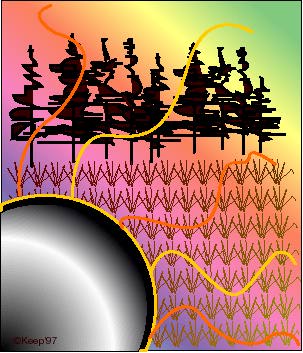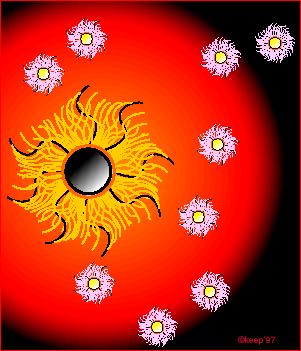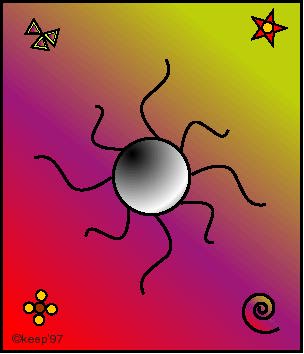Star Flower - A Tale for a New Age.
| By Doug Collicutt | Illustrations by Tom W. Keep |
 |
In the great beginning, all things living under the sun were the same and they were free to do as they pleased. The sun was prosperous and rich with energy which it willingly shared with the living things. But there came a time when the sun, now older and colder, no longer had energy for all. The sun called all the living things to it and told them that it could no longer give up all its energy to them, that they must come up with a plan to share what the sun could spare. |
| After much deliberation, it was decided that some living things would get the sun's energy first, but for this privilege they must not waste the energy, so they became plants, rooted in place, unable to move around and use up the precious gift. The plants would share the sun's energy by giving up parts of their bodies as food to the living things that would become animals. These animals could move about to gather up the energy, then they themselves would share it, through their bodies with other animals. Over and over. |  |
|
The living things sorted themselves into an increasingly complex web of life, making the most of the sun's great gift. As the economy of life grew ever more prosperous, the plants and animals grew more diverse. They were happy and each kind took pride in its own uniqueness. The animals got bigger and faster and became engrossed in the matter of eating, but the plants were content to accept the charity of the sun, though some were growing uneasy and wanted to show the sun their appreciation. |
|
 |
As the sun had to stare down on them all each day, the plants decided to make themselves as beautiful as possible so the sun would have pleasant views as it journeyed across the sky each day, a thank-you in return for the sun's kindness. Trees grew tall and statuesque. Grasses spread wide and danced in the wind. The smaller plants, that could not compete with the grandeur of the trees and grasses, grew colourful blossoms to hold up for the sun to see. |
However, the attempts to please the sun soon became a contest. Each plant strove to be the grandest or the most beautiful. They pressured the sun to name a winner, the most attractive plant of all. The sun took the time to address each plant and hear about how each was trying to please in its own way. |
|
|
But the sun was wise enough to reward all their efforts by recognizing the unique beauty of each one and refused to name a winner. Though, in truth, the sun was particularly appreciative of some plants whose flowers were said to bear the sun's likeness and even allowed them to use the name, sunflower. But one small plant won a special place in the sun's heart, and not by being the biggest or having the prettiest flowers. |
|
 |
The sun asked the small plant why it had chosen to produce a profusion of tiny sun-shaped flowers. The plant responded that it had decided to bloom with the multitude of the stars it saw at night so that the sun could see what the night sky looked like. The sun was stunned. Because of its own brightness the sun had never been able to see the stars, the other suns. The sun had assumed it was alone. To know it had neighbours by the score, that it was not alone, was a wonderful revelation indeed.
|
To the small plant the sun said: "Your name should be aster, the star flower and you shall be the last flower to bloom each year, before winter's onset, to remind me that I am not alone". And from that time onward asters have bloomed in profusion as the summer turns to fall. The End More on asters: Asters - Fall Wildflowers | Manitoba's Asters Another New Age Tale: How Grouse Saved the World |
|
| You can help NatureNorth produce more great articles with a secure donation through PayPal. Our Google Adsense ads pay our server costs, but that's about it. To learn more follow this link: Support NatureNorth. Thank-you! | |
Return to: Fall Issue | NatureNorth Front page

